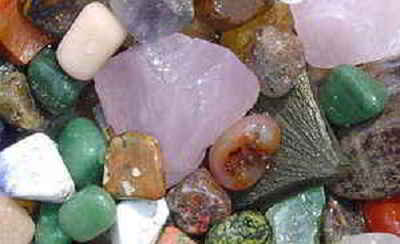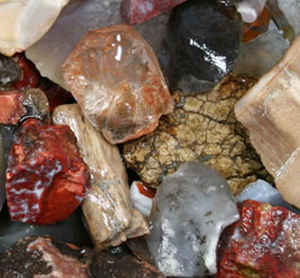
Texas Symbols
Texas State Stone
Petrified Palmwood

(Palmoxylon sp.)
Adopted on March 26, 1969.
Petrified palmwood, (Palmoxylon sp.,) became the state stone of Texas when Governor Preston Earnest Smith signed House Concurrent Resolution No. 12 on March 26, 1969. Petrified palmwood is more properly referred to as a fossil rather than a stone.
Petrified palmwood is a favorite of rock collectors because it is replaced by silica and exhibits well-defined rod-like structures and variety of colors. As a result, it exhibits a wide range of colors and designs when cut that can be incorporated into jewelry and other ornamental items. Because it is composed of silica, it is hard enough to polish and withstand the wear and tear of normal use.
Texas State Stone: Petrified Palmwood

It is from the Oligocene Epoch, 34-23 MYA and can be collected from many scattered East Texas sites. Palmoxylon is the genus designated for petrified trunks of palm. Palms date back to 80 million years ago.
What is now arid Texas was a lush tropical forest 100 million years ago. Trees that fell into mineral-rich mud before having a chance to decay became petrified wood, which is actually a quartz-like stone. The organic wood cells were replaced over time by minerals, often retaining the detailed shape of the original prehistoric wood. Petrified wood is called the most beautiful of fossils.
Petrified palmwood can be found in many parts of the state, but is especially common in the East Texas Piney Woods region and along the Gulf Coast in the Toledo Bend area shared by both the states, Texas and Louisiana. It was left by trees that grew when the Gulf of Mexico's shoreline was much farther north.

The most beautiful of fossils, yes fossils, is petrified wood. Most of the time dead trees lying on the ground decompose completely in as little as three years.
However, oftentimes buried material is gradually replaced by silica and other material like calcite, dolomite and pyrite from water solutions that permeate the rock. This process is called petrification. The most spectacular of this replacement process is that of wood by agate or opal by the action of hot, silica-bearing water. The resulting fossil is more dense and heavier than the wood of the original tree. The state stone of Texas is Petrified Palmwood.
Texas House Concurrent Resolution No. 12
Texas House Concurrent Resolution No. 12,
61st Legislature, Regular Session (1969)
STATE GEM AND STONE
House Concurrent Resolution No. 12
WHEREAS, The State of Texas has not officially designated a State gem or a State stone; and
WHEREAS, The Texas Gem and Mineral Society has adopted appropriate resolutions in support of designating the TEXAS BLUE TOPAZ as the official State
gem and PETRIFIED PALMWOOD as the official State stone; and
WHEREAS, It is appropriate that the 61st Legislature take the necessary action whereby the TEXAS BLUE TOPAZ and PETRIFIED PALMWOOD may be officially
named as the State gem and the State stone, respectively; now, therefore, be it
RESOLVED by the House of Representatives of the State of Texas, the Senate concurring, That the recommendations of the Texas Gem and Mineral Society
be and are hereby adopted, and that the TEXAS BLUE TOPAZ be and is hereby declared to be the official State gem and PETRIFIED PALMWOOD be and is hereby
declared the official State stone of Texas.
Adopted by the House on March 19, 1969; adopted by the Senate on March 24, 1969.
Approved March 26, 1969.
Filed with the Secretary of State, March 26, 1969.
Texas Law
Petrified palmwood was named the official State stone of Texas by House Concurrent Resolution and is not, therefore, listed in the
Texas Statutes.
Only a few of Texas' myriad symbols were actually adopted by an act of the legislature and written into the Texas Statutes.
Taxonomic Hierarchy: Petrified Palmwood
Kingdom: Plantae
(unranked): Angiosperms
(unranked): Monocots
(unranked): Commelinids
Order: Arecales
Family: Arecaceae
Subfamily: Coryphoideae
Genus: †Palmoxylon
Minerals, & Gems

Gemstone, Minerals, Rocks






